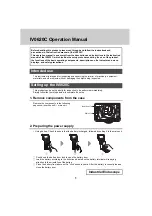
Navigator 600 Phosphate
Multi-stream
7 Calibration & Maintenance
IM/NAV6P/MS–EN Rev. F
43
7.1 Zero Calibration
During the zero calibration the sample is replaced with a zero
phosphate solution. During the zero calibration the system
continues to allow the reagents to flow, allowing the phosphate
content of the reagents to react and therefore be compensated
for in the final measured phosphate value.
Each time the reagents are replenished, a BASELINE
CALIBRATION is initiated. During the Zero calibration section,
the background offset is compensated for and the Zero Offset
parameter is set to 0.0ppm. In a Baseline Calibration the Zero
section is always followed by a Secondary Calibration.
During continuous running the analyzer exhibits a certain
amount of drift (that usually affects the zero calibration) due to:
changes in the reagent solutions
'dirtying' of the cuvette windows.
If this is not compensated for, by carrying out regular
calibrations, significant inaccuracies can be introduced.
The degree of zero drift is indicated by the Zero Offset – see
Fig. 7.3.
7.2 Secondary Calibration
During the Secondary calibration a known value phosphate
(secondary) standard is passed through the normal sample
flowpath, allowing a full chemical reaction to take place. The
phosphate chemistry is so reproducible that this response can
be compared to a theoretical response built into the analyzer.
The theoretical response has an ideal calibration factor of 1.0.
If the response is not perfect, compensation is applied to make
the readings correct and the resulting Calibrating factor provides
an indication of how much compensation is required – see
Fig. 7.4.
If this is within acceptable limits, the calibration passes and the
necessary compensation is applied. If the results are outside
acceptable limits the analyzer shows a calibration fail.
Calibration options comprise:
Baseline (2-point, resets zero) – runs both a zero and a
secondary calibration. Perform this routine only after the
reagents have been replaced or after an annual service.
This routine can only be initiated manually.
Zero (1-point) – required to compensate for any zero drift.
Performed weekly or as required to ensure accurate
phosphate measurement.
Secondary (1-point) – to verify sensitivity (as required) or if
the secondary calibration solution has been replaced.
Zero & Secondary (2-point) – can be performed instead of
a weekly zero calibration to compensate for drift and verify
sensitivity.
Fig. 7.3 Zero Calibration
Theoretical Response
Calibration Factor 1.0
D
is
p
lay and
Read
ing pp
m PO
4
Zero Offset 0.2 ppm
Absorbance
Baseline
Fig. 7.4 Secondary Calibration
100
%
0
%
Theoretical Response –
Calibration Factor 1.0
Analyzer Response
Calibration Factor 0.9
Display and Read
ing p
p
m PO
4
Zero Offset –
0.2 ppm
Absorbance
Baseline
















































